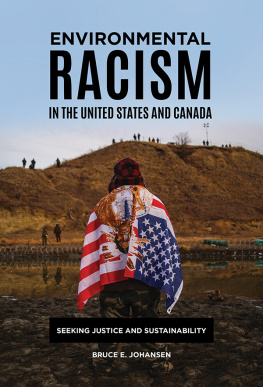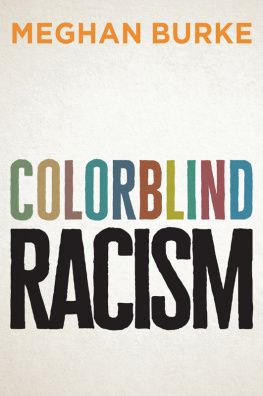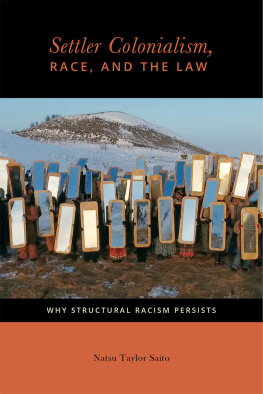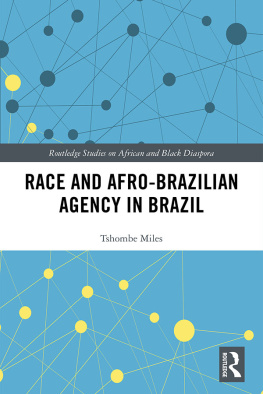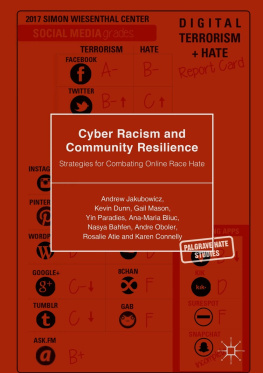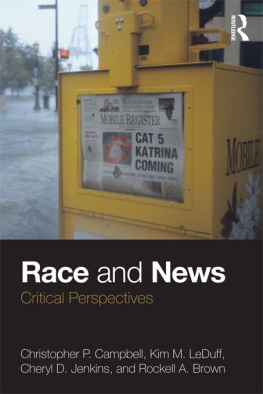RACE AND RACISM IN THE UNITED STATES
An Encyclopedia of the American Mosaic

VOLUME 1
AE
Charles A. Gallagher
Cameron D. Lippard

Copyright 2014 by ABC-CLIO, LLC
All rights reserved. No part of this publication may be reproduced, stored in a retrieval system, or transmitted, in any form or by any means, electronic, mechanical, photocopying, recording, or otherwise, except for the inclusion of brief quotations in a review, without prior permission in writing from the publisher.
Library of Congress Cataloging-in-Publication Data
Race and racism in the United States : an encyclopedia of the American mosaic/Charles A. Gallagher and Cameron D. Lippard, editors.
pages cm
ISBN 978-1-4408-0345-1 (hardback) ISBN 978-1-4408-0346-8 (ebook) 1. United StatesRace relationsEncyclopedias. 2. United StatesEthnic relationsEncyclopedias. 3. RacismUnited StatesEncyclopedias. I. Gallagher, Charles A. (Charles Andrew), 1962editor. II. Lippard, Cameron D., editor.
E184.A1R254 2014
305.800973dc23 2013024041
ISBN: 978-1-4408-0345-1
EISBN: 978-1-4408-0346-8
18 17 16 15 14 1 2 3 4 5
This book is also available on the World Wide Web as an eBook.
Visit www.abc-clio.com for details.
Greenwood
An Imprint of ABC-CLIO, LLC
ABC-CLIO, LLC
130 Cremona Drive, P.O. Box 1911
Santa Barbara, California 93116-1911
This book is printed on acid-free paper 
Manufactured in the United States of America
Contents
Alphabetical List of Entries
Topical List of Entries
Civil Rights
Criminal Justice
Economics
Education
Extremist Groups and Hate Crimes
Government and Politics
Health and Science
Housing
Ideas and Concepts
Identity
Immigration and Migrations
Movements and Activism
Popular Culture
Race Riots
Slavery
Violence
War and Terrorism
Work and Labor
List of Primary Documents
Preface
According to a 2011 USA Today/Gallup poll, a majority of Americans believe the goals of the civil rights movement such as equality of opportunity, socioeconomic mobility, and the eradication of racism and discrimination have been achieved. The same poll found that 86 percent of Americans approve of marriage between blacks and whites. Realize that as recently as 1967 it was illegal in most states for blacks and whites to marry until the Supreme Court struck down these prohibitions in its landmark Virginia v. Loving case that made marriage across the color line legal. According to a 2012 Gallup poll, First Lady Michelle Obama is the second most-admired woman in the United States. Her husband, President Barack Obama, was voted the number one most-respected man in the nation. According to Americans in this poll, five of the women and three of the men ranked in the top ten most-admired individuals were racial minorities. These trends in interracial respect, harmony, and acceptance are historically unprecedented.
What this polling data suggests is that the United States is more tolerant, less racist, and has moved to the point where equal opportunity is afforded to all regardless of creed or color. It would appear that the United States has finally transcended the racial divisions that have divided our nation since its inception. Given the perception of race relations currently held by a majority in the United States, the need for publication of Race and Racism in the United States: An Encyclopedia of the American Mosaic sounds a bit like going to an electronics store and asking to purchase a typewriter or a VHS recorder. The idea and practice of racism, that is, treating individuals differently because of something as superficial as their skin color, is now perceived to be thoroughly outdated, an anachronistic belief and behavior that have more in common with the Jim Crow racism of the 1950s than the supposed era of colorblindness that elected the same black man as president of the United States twice in the twenty-first century.
Occurring alongside this rather optimistic narrative of race relations, however, is a more sobering and problematic story. In 2012 the FBI reported that race-based hate crimes had increased, with the steepest rise in the reported number of anti-Islamic crimes (FBI 2012). In the last five years we have seen new racially loaded words enter the public discourse, words that have quickly become part of the common vernacular of popular culture. The media now speaks of anchor babies, a post-race society, the Dream Act, the Jena Six, Pimps and Hoes Parties, and the New Jim Crow (or often the New Juan Crow). What these words and phrases suggest is that racism, discrimination, and xenophobia are not static categories nor are manifestations of racism like smallpox, an age-old disease that through scientific, government, and public efforts was eradicated. The racial hierarchies that remain in place in the United States are dynamic socioeconomic systems that evolve, mutate, and are constantly being reconstituted to maintain and reorder race-based privilege. It is because race is a fluid category in a constant state of flux and redefinition and the reality that race and racism continue to shape the life chances of all Americans, that an encyclopedia of race, written by race and ethnicity scholars, is still very much needed.
It is with this need in mind that Race and Racism in the United States was produced. We have assembled race scholars from around the country to examine race and racism from almost every conceivable perspective. From a historical viewpoint we detail how the concept of race emerges in the 1600s as a cultural or geographic designation and slowly morphs into a wholly fabricated scientific category only to be reframed, defined, and understood in the twentieth and twenty-first centuries as a grouping that is socially and politically constructed.
Hundreds of entries throughout the Race and Racism describe the myriad ways racism and discrimination are articulated and expressed by individuals and institutions. For example, both racism and discrimination can be found in entries as wide ranging as housing, government policy, the military, the media, and the criminal justice system. From a social, psychological, and theoretical perspective, race and racism are addressed in entries like modern racism, laissez-faire racism, institutional discrimination, and racist ideologies like eugenics and white supremacy. Just as every facet of how race and racism are described through hundreds of entries, so too are the people and institutions that fought, and continue to fight, to eradicate racism, prejudice, and discrimination. This includes entries on abolitionists from the Civil War era to modern-day civil rights leaders.


